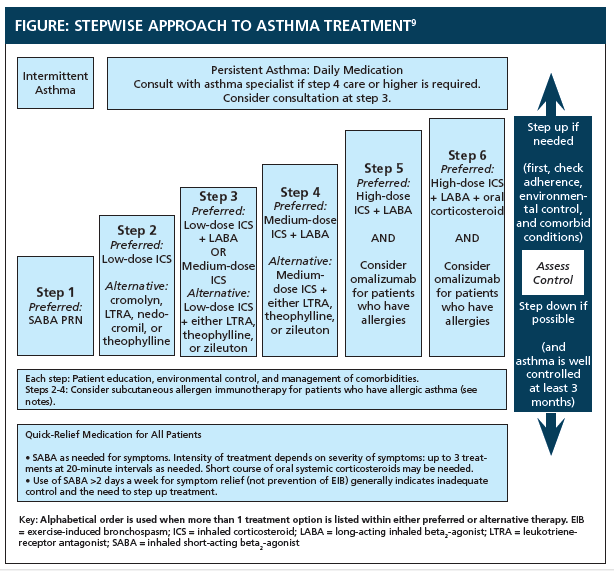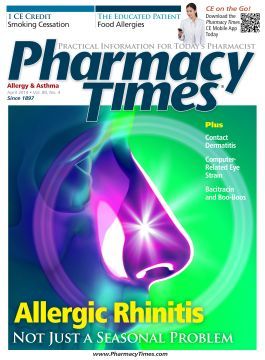Publication
Article
Pharmacy Times
Managing Asthma: The Pharmacist's Role
Author(s):
Patient education on asthma can reduce related hospitalizations, emergency visits, and deaths.
Patient education on asthma can reduce related hospitalizations, emergency visits, and deaths.
According to the Centers for Disease Control and Prevention, an estimated 25 million individuals in the United States have asthma and the number of diagnosed cases increases annually.1 Moreover, 1 in 11 children and 1 in 12 adults have asthma.2 Asthma accounts for more than 10 million missed days from work and an estimated 13 million missed school days annually because of uncontrolled symptoms (Online Table 1).2,3
Table 1: Common Symptoms of Asthma
- Frequent coughing
- Trouble sleeping due to coughing and wheezing
- Wheezing
- Shortness of breath or trouble breathing
- Pain or tightness in the chest
Adapted from references 2 and 4.
Asthma is considered to be the most chronic disease in childhood and affects an estimated 7 million children.4 Two-thirds of all asthma cases are diagnosed before patients are 18 years of age, but studies show that an estimated 50% of pediatric patients diagnosed with asthma often see a reduction or disappearance of symptoms by early adulthood.4
Pharmacists can be instrumental in providing patients with valuable resources to educate them about pharmacologic agents for treating and managing asthma. Pharmacists can educate patients about the proper use of inhalation devices, especially newly diagnosed patients who may be overwhelmed with diagnosis and treatment plans. As more treatment options and patient resources become available for controlling asthma, a collaborative effort between health care professionals and patients, coupled with patient education and stressing the importance of patient adherence, is fundamental for effectively controlling asthma. For successful management of asthma, it is important that patients be thoroughly educated about their condition, know the warning signs of asthma attacks, know the factors that may trigger an attack (Online Table 2), know how to manage attacks, adhere to their asthma plan, and know how to properly use the prescribed treatment.5 Results from various studies show that increasing awareness and promoting education about asthma can reduce the numbers of asthma-related hospitalizations, emergency department visits, missed days at school and work, and deaths.2,4
Table 2: Possible Triggers of Asthma Attacks
- Respiratory infection
- Physical activity, including exercise
- Stress
- Exposure to cold air or sudden changes in temperature
- Exposure to irritants such as cigarette smoke, air pollution, chemicals, dust, or aerosol sprays
- Allergens such as mold, pollen, dust mites, and pet dander
- Pharmacologic agents such as aspirin, nonsteroidal anti-inflammatory drugs, and nonselective beta-blockers
Adapted from references 2 and 5-8.
Treating Asthma
Treatment plans for asthma entail the management of acute asthma attacks and chronic symptoms. The National Asthma Education Prevention Program (NAEPP) recommends a stepwise approach for asthma management that tailors medication to the severity of the asthma and the patient’s individual needs (Figure). The NAEPP Guidelines for the Diagnosis and Management of Asthma can be found online at www.nhlbi.nih.gov/guidelines/asthma/asthgdln.htm.

The drug classes commonly used for treating asthma are (1) maintenance or long-term (controller) medications and (2) quick-relief (rescue) medications. Maintenance medications, which should be taken daily, are indicated for controlling asthma symptoms and avoiding flare-ups; rescue medications, such as short-acting inhaled bronchodilators, are used to relieve asthma attacks or to prevent exercise-induced asthma.4,7,10,11 Examples of long-term control medications include inhaled corticosteroids, long-acting beta2-agonists, leukotriene modifiers, methylxanthines (theophylline), and immunomodulators.7,10,11
According to the NAEPP, current guidelines recommend long-term treatment with inhaled corticosteroids because they are very effective in decreasing airway inflammation compared with any other single long-term control medication. 10-12 Using a combination of long-acting beta2-agonists and inhaled corticosteroids is effective and safe when inhaled corticosteroids alone are insufficient, and such combinations may also serve as an alternative to increasing the dosage of inhaled corticosteroids.12
Rescue medications, such as short-acting beta2 agonists, rapidly relieve symptoms by relaxing airway muscles and should be used as needed during an asthma flare-up or taken before exercise.7,10-12 Patients who need to use rescue medications more than twice a week should inform their primary health care provider because this may indicate inadequate control of symptoms, which may require a change in the patient’s treatment plan.10-12
In general, the goals of treating asthma are to control the disease and improve the patient’s quality of life (Online Table 3). Effective therapy will prevent chronic symptoms such as shortness of breath and coughing, decrease the need for rescue medications, help maintain good lung function, and enable patients to resume normal activity.10-12
Table 3: Factors Affecting Asthma Control*
- Appropriate medications
- Patient’s willingness to use medications
- Developing a written asthma action plan to guide patients in self-management
- Identifying asthma triggers
- Implementing environmental measures to control allergies, irritants, and pollution when feasible
- Treating comorbid conditions that may exacerbate asthma, such as allergic rhinitis, gastroesophageal reflux disease, obesity, and sleep apnea
- Educating patients about their asthma treatment plan and how to manage their asthma
- Stressing the importance of patient adherence to the selected treatment plan
- Routine monitoring of therapy, response to therapy and follow-up
- Adjusting therapy when warranted.
*
According to guidelines from the National Asthma Education and Prevention Program.
Adapted from references 20-22.
Unfortunately, nonadherence with regard to asthma treatment continues to be an issue, and some reports show adherence rates as low as 50%.13-20 This lack of adherence results in poor patient outcomes and may be associated with increased rates of morbidity and mortality among affected patients.14,15 Many factors have been identified as contributors to nonadherence; examples include difficulties with inhalation devices; use of multiple medications; presence of other disease states; adverse effects; cost of medications; complex medication regimens; lack of understanding or instruction regarding asthma, the medications, or the treatment plan; and lack of follow-up with a primary health care provider.14-20
Patient Counseling
During counseling, patients and caregivers of children with asthma should be educated on the basics of asthma; the goals of treatment; how to manage triggers; how to properly use metered-dose inhalers; the importance of adhering to therapy, refilling prescriptions on time, and carrying rescue medications at all times because attacks may occur without warning; and how to use maintenance and rescue medications.3,4,11,20-22 Because patients with asthma are at an increased risk for developing respiratory complications from infections such as influenza and pneumonia, patients should be encouraged to obtain a yearly inactivated influenza vaccination.20-22
Although asthma is a chronic condition, it can be successfully managed through patient education and adherence (Online Table 4); with effective therapy, patients can lead normal, healthy lives.
Table 4: Patient Resources on Asthma
- American College of Allergy, Asthma & Immunology website: www.acaai.org/allergist/asthma/asthma-treatment/Pages/default.aspx
- National Asthma Education and Prevention website: www.nhlbi.nih.gov/health/public/lung/index.htm#asthma
- American Lung Association website: www.lung.org/lung-disease/asthma/learning-more-about-asthma/
- American Academy of Allergy, Asthma & Immunology website: www.aaaai.org/conditions-and-treatments/asthma.aspx
- The National Heart, Lung, and Blood Institute website: www.nhlbi.nih.gov/health/public/lung/asthma/asthma_atglance.pdf
- Asthma and Allergy Foundation of America website: http://aafa.org
Patients and caregivers should understand the importance of using medications as directed and maintaining regular visits with their primary health care provider to assess response to therapy and to make changes if warranted. In addition, health care professionals should encourage patients and caregivers to take an active role in their asthma treatment plan. By doing so, they are empowering themselves with knowledge about their medications and asthma plan. The following are 2 of the best resources for helping patients control asthma and enjoy life:
- CHEST Foundation and the American College of Chest Physicians website: http://onebreath.org/document .doc?id=30
- The National Institutes of Health National Heart, Lung and Blood Institute website: www.nhlbi.nih.gov/guidelines/asthma/asthma_qrg.pdf
Ms. Terrie is a clinical pharmacist and medical writer based in Haymarket, Virginia.
References:
- Asthma in the US Centers for Disease Control and Prevention website. www.cdc.gov/VitalSigns/Asthma. Accessed March 3, 2014.
- Asthma’s impact on the nation. Centers for Disease Control and Prevention website. www.cdc.gov/asthma/impacts_nation/asthmafactsheet.pdf. Accessed March 3, 2014.
- National Asthma Control Initiative. National Institutes of Health National Heart, Lung, and Blood Institute website. www.nhlbi.nih.gov/health/prof/lung/asthma/naci/pubs/naci-factsheet.pdf. Accessed March 3, 2014.
- Morris MJ. Asthma. Medscape website. http://emedicine.medscape.com/article/296301-overview. Accessed March 3, 2014.
- What is asthma? Centers for Disease Control and Prevention website. www.cdc.gov/asthma/faqs.htm. Accessed March 3, 2014.
- Asthma in adults fact sheet. American Lung Association website. www.lung.org/lung-disease/asthma/resources/facts-and-figures/asthma-in-adults.html. Accessed March 3, 2014.
- Asthma. Merck Manual for Healthcare Professionals Online Edition website. www.merckmanuals.com/professional/pulmonary_disorders/asthma_and_related_disorders/asthma.html. Accessed March 3, 2014.
- What are the signs and symptoms of asthma? National Institutes of Health National Heart, Lung, and Blood Institute website. www.nhlbi.nih.gov/health/health-topics/topics/asthma/signs.html. Accessed March 3, 2014.
- Expert panel report 3 (EPR-3): Guidelines for the Diagnosis and Management of Asthma. National Institutes of Health National Heart, Lung, and Blood Institute website. www.nhlbi.nih.gov/guidelines/asthma/asthgdln.htm. Accessed March 3, 2014.
- Asthma. American Academy of Allergy, Asthma & Immunology website. www.aaaai.org/conditions-and-treatments/asthma.aspx. Accessed March 3, 2014.
- How is asthma treated and controlled? National Institutes of Health National Heart, Lung, and Blood Institute website. www.nhlbi.nih.gov/health/health-topics/topics/asthma/treatment.html. Accessed March 3, 2014.
- Elward KS, Pollart SM. Medical therapy for asthma patients: updates from the NAEPP Guidelines. Am Fam Physician. 2010;82:1242-1251.
- Boulet LP, Vervloet D, Magar Y, Foster JM. Adherence: the goal to control asthma. Clin Chest Med. 2012;33(3):405-417.
- Gillisen A. Patient’s adherence in asthma. J Physiol Pharmacol. 2007;58(suppl 5):205-222.
- Divertie V. Strategies to promote medication adherence in children with asthma. Am J Matern Child Nurs. 2002;27(1):10.
- Sumino K, Cabana MD. Medication adherence in asthma patients. Curr Opin Pulm Med. 2013;19(1):49-53.
- Bender BG, Bender SE. Patient-identified barriers to asthma treatment adherence: responses to interviews, focus groups, and questionnaires. Immunol Allergy Clin North Am. 2005;25:107.
- Global strategy for asthma management and prevention. Global Initiative for Asthma website. www.ginasthma.org/documents/4. Accessed March 3, 2014.
- Williams LK, Joseph CL, Peterson EL, et al. Patients with asthma who do not fill their inhaled corticosteroids: a study of primary nonadherence. J Allergy Clin Immunol. 2007;120:1153.
- Weinstein AG. Should patients with persistent severe asthma be monitored for medication adherence? Ann Allergy Asthma Immunol. 2005;94(2):251-257.
- Asthma care quick reference: diagnosing and managing asthma. National Institutes of Health National Heart, Lung, and Blood Institute website. www.nhlbi.nih.gov/guidelines/asthma/asthma_quickref.htm . Accessed March 3, 2014.
- Asthma: treatment and management. American Academy of Allergy, Asthma and Immunology website. www.aaaai.org/conditions-and-treatments/asthma.aspx. Accessed March 3, 2014.

Newsletter
Stay informed on drug updates, treatment guidelines, and pharmacy practice trends—subscribe to Pharmacy Times for weekly clinical insights.






